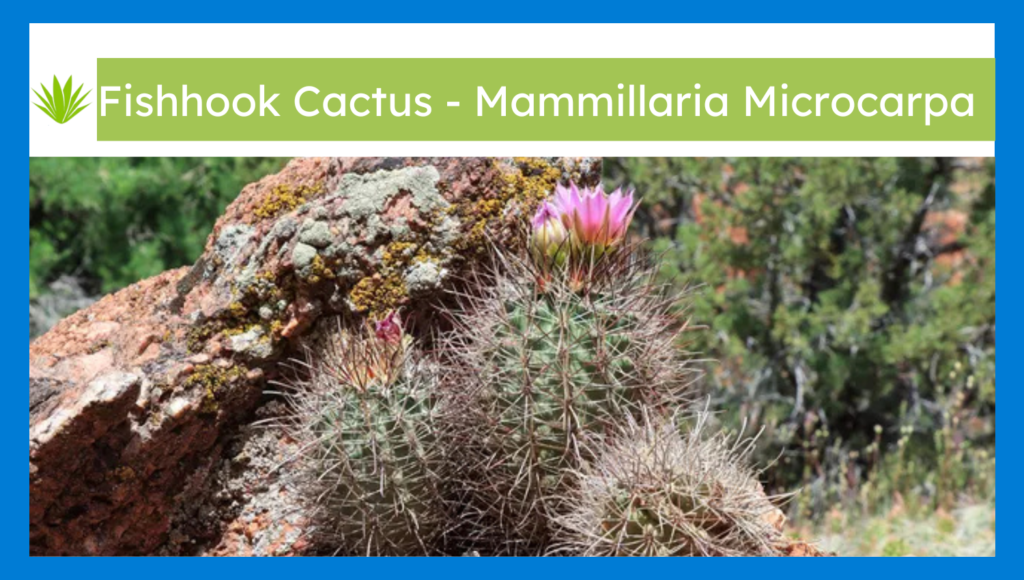Every year the Fishhook cactus (Mammillaria Microcarpa) builds itself into a globe-shaped cactus form right in the southwestern United States desert regions and Mexican landscapes. This species of plant forms a maximum height of 15 cm alongside 10 cm in width while adapted to survive in desert areas with exposed rocks. This desert plant has earned its name through the curved hook-like spines that protect it by deterring animal attacks. The cactus shows its pink to reddish petals in spring and summer creating a round crown at its apex. After blooming small red edible fruits develop on the plant which attracts desert wildlife for consumption. The Fishhook cactus displays high drought tolerance in desert ecosystems while serving critically important functions by boosting ecosystem biodiversity and maintaining ecological stability.
| SR# | Characteristic | Description |
| 1 | Size | 6 to 12 inches tall, small and compact. |
| 2 | Appearance | Small, rounded body with dense spines. |
| 3 | Spines | Curved, hook-shaped spines, often in clusters. |
| 4 | Flowers | Small, pink or white flowers, usually near the apex. |
| 5 | Fruits | Red or orange, spherical fruits. |
| 6 | Root System | Shallow, well-adapted to retain water in arid conditions. |
| 7 | Lifespan | 20 to 30 years. |
| 8 | Habitat | Dry deserts, rocky slopes, and open areas. |
| 9 | Water Storage | Stores water in the fleshy body. |
| 10 | Growth Rate | Slow, about 1 inch per year. |
| 11 | Flowering Time | Spring to early summer. |
| 12 | Reproduction | Seeds dispersed by animals and wind. |
Table of Contents
How to Grow, Bloom, and Care for a Fishhook Cactus?
Plant your Fishhook cactus (Mammillaria Microcarpa) in sand or rocky potting mix to promote drainage through drainage holes if you intend to use a container with holes. Sunlight access directly outside can duplicate its desert-growing environment. Give your Fishhook cactus sparse water but let the soil dry completely between each session and decrease your watering during the winter season. It is essential to provide ample sunlight to your cactus in the springtime, along with occasional springtime application of cactus-specific fertilizer. Place it where temperatures stay warm while keeping it protected from frost. Trimming away dead flowers alongside dead spines helps your desert plant grow strong. Correct gardening practices create intense flowering along with healthy growth that enhances this cactus’s value for both indoor and outdoor desert garden spaces.
Why is it called the Fishhook Cactus, and Why is the Tobusch Fishhook Cactus Endangered?
The Fishhook cactus earns its name because it develops curved spines that function as protective Fishhooks against animal predators. The rare Tobusch Fishhook cactus (Sclerocactus brevihamatus subsp. tobuschii) faces endangerment because its natural habitats diminish alongside human intrusion and invasive species existence. As a native Texan plant, the Tobusch Fishhook cactus inhabits limestone stream ecosystems and grassland environments. Too many variables including changes in climate, land development activities, and grazing that exceed appropriate limits endanger this Texas native plant’s survival. The low numbers of individuals combined with a small population make the cactus highly likely to become extinct. Protecting the rare cactus requires both habitat conservation solutions and established protective legislation since its survival stands as an essential for its ecological ecosystem which provides soil stability and pollinator support.
Where does the Fishhook Barrel Cactus Live, and What Zones Does it Grow in?
The Fishhook barrel cactus (Ferocactus wislizeni) occurs naturally within the southwestern regions of the United States and northern Mexico. The Fishhook barrel cactus (Ferocactus wislizeni) develops naturally in the Sonoran and Chihuahuan desert regions. This cactus lives successfully in sandy and rocky soils between 1,000 and 4,500 feet in elevation. This species survives in hardiness zones 9 through 11. The plant successfully grows in sunny conditions coupled with arid regions.
What are the Adaptations and Appearance of the Fishhook Barrel Cactus?
Fishhook barrel cactus (Ferocactus wislizeni) develops cylindrical body forms that contain water reserves in its ribs. The Fishhook spines function both as water-conserving mechanisms and as defensive tools against interested herbivores. The cactus develops into a plant that reaches heights between 6 and 10 feet. This species displays yellow summer flowers that mature into orange blooms. The plant has edible yellow soft fruits. The Fishhook barrel cactus exists in dry areas thanks to its epidermis covered in wax and its shallow root system.
Is the Water Inside a Fishhook Barrel Cactus Drinkable and Clear?
The water stored in Fishhook barrel cactuses (Ferocactus wislizeni) remains unsafe to drink. The substance presents a thick and bitter texture which leads to stomach distress. Intake of Fishhook barrel cactus results in vision distortions yet continued use eventually leads to dehydration. Those who drink this water experience dry skin alongside stomach difficulties. Many cacti cultivate water as their main survival strategy against desert environmental challenges. Humans should avoid drinking water out of these plants because the water inside does not appear clear. Drinking the cactus water benefits the plant it protects yet delivers minimal hydration advantage for people.
About The Author
Isaiah Espinoza
Isaiah Espinoza is the proud company owner, founder and driving force behind Legacy Landscaping and Design. Isaiah established Legacy Landscaping & Design in 2014, bringing his vision of creating stunning outdoor spaces to life. Isaiah, the founder of Legacy Landscaping & Design, has a deep-rooted passion for construction and design, stemming from four generations of family expertise in the industry. With a KB-1 General Building License and a CR-21 Hardscaping and Irrigation License, Isaiah has spent the past decade transforming outdoor spaces with exceptional craftsmanship and innovative design.

